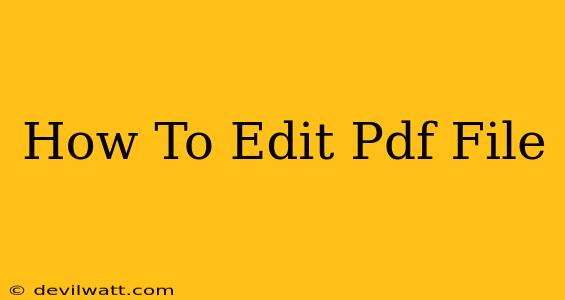Editing PDF files used to be a major headache. Now, thanks to a variety of tools and techniques, it's become significantly easier. Whether you need to make a quick correction or perform a major overhaul, this guide will show you how to edit PDF files effectively.
Understanding PDF Editing Limitations
Before diving into the methods, it's important to understand that PDFs aren't designed for the same level of direct editing as word processing documents. While you can modify text and images, some edits might result in a less-than-perfect visual outcome, especially with complex layouts. The best approach often depends on the complexity of your edit and the original PDF's creation method.
Methods for Editing PDF Files
Here are several ways to edit PDF files, ranging from simple tweaks to more extensive modifications:
1. Using Online PDF Editors
Many free and paid online PDF editors allow you to edit text, images, and even add annotations. These are often the easiest option for minor changes. Advantages: No software installation required. Disadvantages: May have limitations on file size or features, potential security concerns depending on the provider. Popular options include Smallpdf, PDFescape, and Sejda.
2. Employing Dedicated PDF Editing Software
Applications like Adobe Acrobat Pro are powerful PDF editors offering extensive features. They allow for precise control over text, images, and layout. Advantages: Comprehensive editing capabilities, high-quality results. Disadvantages: Often expensive, requires software installation and learning curve.
3. Leveraging Microsoft Word or Google Docs
If the PDF was originally created from a Word document or similar file, you may be able to open it directly in Word or Google Docs. These applications often retain the formatting, allowing for easier editing. Then, you can save the changes back to a PDF. Advantages: User-friendly interfaces, familiar functionalities. Disadvantages: Might not preserve the formatting perfectly for all PDFs, especially if the original was scanned or created from another program.
4. Editing Text Within PDF Files
For simple text edits, some PDF viewers have basic editing capabilities built-in. This usually involves selecting the text and typing the correction. However, this method is often limited and may alter the overall formatting.
5. Adding Annotations and Comments
Many PDF readers allow you to add annotations, comments, highlights, and other markings without directly altering the underlying document. This is ideal for reviewing and collaborating on documents.
Choosing the Right Method
The best method for editing your PDF depends on several factors:
- The type of edit: Minor text correction? Major layout changes? Adding images?
- Your technical skills: Are you comfortable using advanced software?
- Your budget: Are you willing to pay for premium software or services?
- The security and privacy of your PDF: Be cautious about using free online services for sensitive documents.
Tips for Successful PDF Editing
- Always save a backup copy: Before making any edits, create a backup of your original PDF file to avoid data loss.
- Consider the file format: If you're making significant changes, consider converting the PDF to a more editable format (like Word) first, then converting it back to PDF after editing.
- Start with simple edits: If unsure, begin with simple text edits or annotations before tackling more complex modifications.
- Check for errors: After editing, thoroughly review the PDF to ensure all changes are correct and the formatting is intact.
By carefully considering these methods and tips, you can effectively edit your PDF files and achieve the desired results. Remember to always choose the tool best suited for your specific needs and comfort level.

